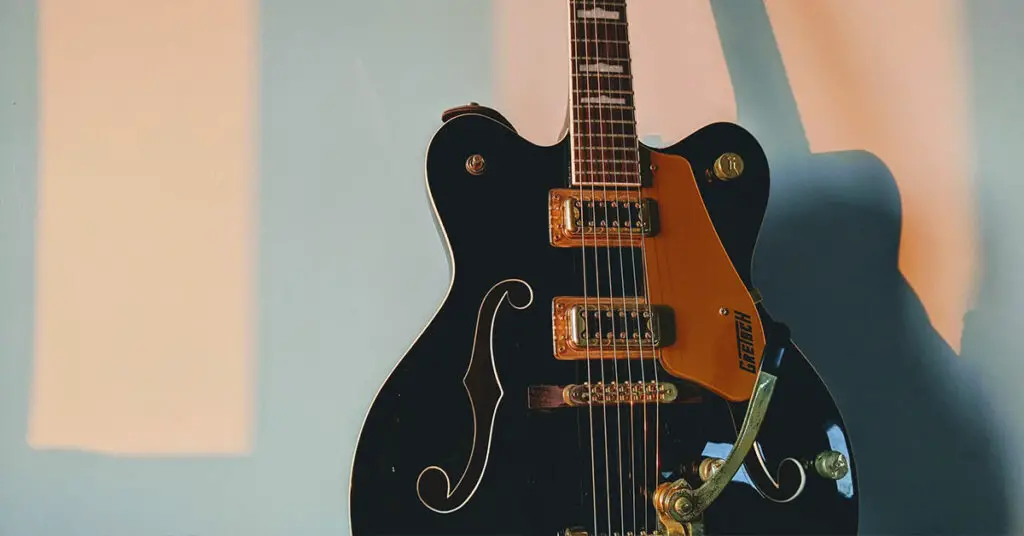Guitars are among the most popular instruments worldwide. They are no longer simple instruments used for playing 1 to 2 tunes but are high-end tonal and modern machines with numerous controls.
The current guitars come with new gear, shapes, different playing frequencies, and other functions.
Brands and sale prices are not the only factors differentiating guitars now. Another essential factor is their overall shape- Arch-top and flat top.
Both shapes have various benefits and give out different sounds ideal for different settings. However, arch-tops, as well as flat top guitars, are excellent choices for any guitarist.
Therefore, it is arch-top vs. flat top guitars. But don’t be alarmed because we are here to help you pick the guitar that is the best for you! Let’s look into each guitar type in more detail:
Table of Contents
What Are Archtop Guitars?
The name ‘arch-top guitars’ gives most guitarists quite a clear hint about what they are. You may think of instruments with standard pickups (humbuckers or single-coils) and hollow bodies when playing an arch-top guitar.
Arch-tops guitars are all that and more since there are considerable advancements in the music industry now.
The arch-top guitars have a curved top, but some may even have a curved back. The arched body is the characteristic feature of this instrument.
An arch-top guitar also has an adjustable bridge, a few humbucker pickups if it is semi-acoustic, and F-shaped holes all along the body.
The arch-top guitars may be electric or acoustic. The latter is rarer but is best for playing jazz music.
An acoustic arch-top guitar may also come with one or more magnetic pickups. However, it is a standard acoustic guitar as it comes with a piezo only.
The F-shaped sound holes in the body are pretty standard in arch-top guitars, but they may be other shapes occasionally.
The number of sound holes, however, is limited to 2 only. You will find them on both the treble and bass sides.
The arch-top guitar can be played as an electric as well as acoustic guitar, and both can be played in similar settings. Another type is semi-acoustic; this is also advantageous and can be played in live and virtual performances.
The arch-top guitars, such as the Gibson Les Paul models, usually have solid bodies. Other arch-top guitars showcase semi-hollow bodies.
These electric guitars come with arched tops, for instance, the Gibson’s ES-335. However, arch-top mainly refers to acoustic-electric guitars or big jazz-oriented acoustic guitars.
They can be recognized from afar from their carved bodies, separate tailpiece, and floating bridge. The arch-top guitars offer detailed punchiness and enhanced projection in a wide variety of backgrounds.
- Standard pickups (humbuckers or single-coils) and hollow bodies
- Characteristic feature- curved top or back
- It comes with an adjustable bridge, humbucker pickups (semi-acoustic), and F-shaped holes
- Works as an acoustic and electric guitar
- Solid or semi-solid bodies
- Feature carved bodies and a separate tailpiece
- Ideal for live performances
What Are Flat Top Guitars?
Are all the guitars with flat tops flat top guitars? Or do they need to have more features to be considered on this list? For the more significant part, flat top guitars are the standard acoustic guitars.
These are the average guitars you pass by in music stores and in most song videos. The flat-top guitars are also known as western-style steel-string guitars.
Often used as leading and backing guitars, the flat top guitars have a wooden soundboard made of spruce, mahogany, or cedar.
This thin wooden piece (2 – 3 mm in most cases) is strengthened by various types of internal bracings- a quality that determines the instrument’s sound quality.
Generally, the sound is produced by the guitar top’s vibration as the strings transfer energy into the air.
Different wood bracing patterns have been used throughout the years not only to support the top from collapsing under the intense pressure exerted by the strings but also to resist the resonating top.
The Martin D-28 is a popular example of the flat-top guitar, an acoustic steel-string guitar. Just like arch-top guitars, flat top guitars can also be used as electric guitars.
The other examples include the Gibson SG and Fender Telecaster.The flat-top acoustic guitar has a larger body than a classical guitar, along with a stronger structural design and narrow, reinforced neck.
The steel strings exert extra tension leading to a brighter and louder tone. It is a staple for old-time folk music and blues.
- Standard acoustic guitars
- Similar to typical music store guitars
- It mostly features a wooden soundboard made of spruce, mahogany, or cedar
- The wooden piece determines the instrument’s sound quality
- It comes with different wood bracing patterns
- It can be used as an electric guitar
- Come with a large body, solid structural design, and narrow, reinforced neck
- Features steel strings
- Produces a brighter and louder tone
- A staple for old-time folk music and blues
Arch-top vs. Flat-top Guitars
There are several types of arch-tops and Flat top guitars, including acoustic and electric guitars. The arch-top jazz guitars are handy only in a limited number of settings.
Apart from blues and jazz, you will usually find them in some rockabilly bands and the classic rock n roll recordings.In an arch-top guitar comparison, the flat-top solid-body electric guitars are pretty much all over the place.
You will not come across any significant sonic distinction between the flat-top electric guitars and arched-top solid-body guitars. For instance, the Gibson Les Paul Special and an SG have the same uses as a Gibson Les Paul Standard.
- Arch-top jazz guitars are useful only in a limited number of settings, including blues, jazz, rockabilly bands, and classic rock n roll recordings
- Flat-top guitars used in a wide variety of settings
- No significant sonic distinction between arch-top and flat-top guitars
- The tone and performance of the arch-top and flat-top guitars vary
- Similar uses
Arch-top vs. Flat-top Banjo
The term ‘arch-top banjos’ is used for banjos with a tone ring sitting concentrically inside the guitar’s rim. Usually, the banjo is found at the top of the rim in the flat top guitar construction.
Several beginner and experienced guitarists consider the arch-top vs. the flat-top banjo.
The experts have put an end to this debate by saying that the banjo primarily depends on the player and their technique; the instrument does not carry significant value.
If the method you are playing with is correct, the arch-top or flat-top feature only holds secondary importance.
Arch-top vs. Flat Top Acoustic Guitars
There is a considerable difference between arch-tops and flat-top acoustic guitars. The main one, however, is between the tone and performance of each of the instruments and whether it is entirely acoustic or semi-acoustic.
The flat-top acoustic guitar dynamic is that its neck and body pull against each other. On the other hand, the arch-top acoustic guitars have different construction, resembling violins.
They have strings that push down on the guitar’s body.
The flat-top guitars also have a different tone overall; it is more precise and crispier.
The instrument is said to have a somewhat percussive feel. The arch-top guitars have a lesser bright sound in comparison.
A remarkable feature of the arch-top guitars is that their tone is rounder and smoother than the flat-top’s.
Although almost dull, it is still pleasing to the ears. But most experts believe that an arch-top guitar performs best in jazz or blues music.
The arch-top guitars are not your typical cowboy chords since the tone is spread out over a broad spectrum and comes out evenly.
This apparently dark and smooth tone is most compatible with small chords, played at a rate of no more than 3 to 4 at a time. Ideally, the arch-top acoustic guitars work best for 3-note chords.
Nonetheless, different players are of the opinion that arch-top guitars bring greater volume than flat-top guitars. The latter, however, produces a more sustained beat.
The arch-top guitars are also known to project more sound in front of the user, while the flat-top guitar envelops the player.
The arch-tops are also mostly used as electric guitars as they get the tone going as soon as they are plucked into an amp. The flat-top guitars work better for old, classical music.
Flat Top Guitars:
- The neck and body pull against each other in flat-top guitars
- Flat top guitars have a crispier and clearer tone with a percussive feel
- Produce a sustained beat
- Ideal for old, classical music
Archtop Guitars:
- Produces sounds that envelop the guitarist
- Arch-top guitars have a rounder and smoother tone
- The tone spreads out over a broad spectrum and comes out evenly
- Arch-top guitars perform best in jazz or blues music
- Strings push down against the body in arch-top guitars
- Most compatible with small chords, ideally 3 to 4 notes
- Projects more sound in front of the guitarist
- Greater volume
Archtop Vs. Flat Top Guitars- A Quick Review
The arch-top guitars are more like the contemporary electric guitars, ideal for the current popular music genres. The flat-top guitars, in contrast, work better for old music genres.
The arch-top guitars also have more treble and less bass. They are not as loud as the flat top but have a thinner sound that produces more cuts.
The arch-top guitars play great for lead singers, jazz, and blues as they all require clear and clean beats playing over several other instruments.
They also work exceptionally well for a subtle rhythm guitar as you can tone them down for a lesser noticeable sound.
The flat-top guitars may produce a lot of buzzing and muddiness if played loudly or the same way as the arch-top. They are acoustic steel string guitars like the famous Martin D-28 and Fender Telecaster.



![HERE’S What Happened to the Soul Singer Al Green [2023 Update]](https://performerlife.com/wp-content/uploads/2023/04/what-happened-to-al-green-211x150.jpg)
